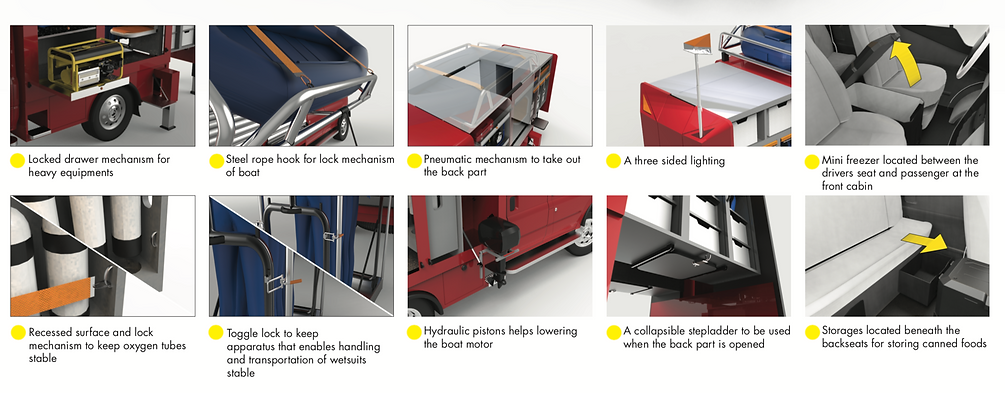Search & Rescue Vehicle Design
Designing underwater search and rescue vehicle to provide divers better working conditions for diving squads
The Challenge
This project was given as a group project in 2015 for the senior year of the METU Industrial Design department in cooperation with Karba. Karba company is manufacturing vehicles in truck-mounted specialized fire fighting trucks.
In this project, we were asked to go to the Ankara Fire Department to examine different types of vehicles such as fire fighting vehicles, rapid intervention vehicles, search and rescue vehicles, K-9 Dog vehicles.
We did not have the opportunity to see the vehicles in action, but we had a chance to make interviews with the employees. We examined all the vehicles for days and even made trips.

My Role



Groups of 5 people were formed for this project and as you can see our team was the most fun. :) Each of us had different strong skills but we have worked together in all phases of the project equally.
The Goal
The purpose of this project was to develop a seamless experience for the employee of the firefighting department. We have needed to choose one from among various kinds of vehicles and focus its problems.
They wanted us to design the apparatus mounted back of the vehicle and choose a ready-made vehicle for the front part.
The Discovery
Pre-Research
At the beginning of the project, we looked at Karba's competitors, their specialized vehicles and their features.
After that, we went to the fire department of our city to see all kinds of vehicles to understand the problems.
After a quick ideation session with the team, we decided to focus on the underwater search and rescue vehicle because there was plenty of room for development.

Prominent Problems
-
Search and rescue vehicle has a capacity of 6 people to transport.
-
Search and rescue operations for cases like being castaway and drowning in a lake, barrage etc.
-
There are not many vehicles specialized in underwater search and rescue squads.
-
The usual problem is storage and accessibility to types of equipment in these storages.



On-site Research and In-depth Interview
After choosing the search&rescue vehicle, we went to the fire department to see the car on-site again and discover the usage scenarios. Also, we have had an interview with the actual divers to understand their journey from beginning to end.

The Ideation
Creating Usage Scenarios
_JPG.jpg)

After analyzing the research findings, we sketched the usage scenarios of the main problems. For each problem, we shared more than five solutions and received feedback.
Accordingly, we developed our solutions in selected scenarios by receiving feedback for weeks.
While producing all our solutions, we did our best to have the following themes;
We have listed the most important problems below and explained our solutions through sketches.
The Problems and Solutions
Finding #1

Solution #1

Divers need both vehicles for the missions which are Iveco Daily, Mercedes Splinter. The heavy equipment and the boat is carried in the bigger vehicles while the suits and personal equipment are carried in the smaller one.
Designing a vehicle for carrying every piece of equipment at once and together.
Finding #2

They are obliged to wash the suits in the lake. Sometimes, they can change their outfit outside in harsh weather conditions.
Solution #2

Creating a space in the vehicle for changing outfits.
Finding #3

Divers store their equipment in personal boxes, but they are stored disorderedly.
Finding #4

Other types of equipment are required to dry.
Finding #5

The boat is impossible to be lowered by just one person because of its size and weight.
Finding #6

It is not possible to lower the boat motor by
one person due to its heavy weight.
Solution #3

Creating meaningful spaces to organize the equipment and boxes properly.
Solution #4

Storing and drying with the usage of a suit hanger.
Solution #5

Forming a specialized system for lowering the
boat by just one person.
Solution #6

Lowering the boat motor easily with the use of pistons.
Weight Analysis
Choosing the Right Vehicle
We selected the most suitable vehicle by performing weight and balance analysis.

Ford Transit 350 M

The Design
In this phase, we shared our solutions with our lecturers based on a more technical sense. We developed our proposals for two weeks over sketches and mock-ups.

Meeting with the lecturers

Mock-ups
The Placement of Equipment


Usage Scenarios
The latest design of a vehicle is presented according to usage scenarios such as the accessibility of personal equipment and its placement, dressing area, lowering the boat, drying clothes.


Design Details
The Final Design


.png)

.png)
Interior
Exterior

The Prototype
The Jury Day

You can see the photo of the final presentation, jury day. :) In this project, we carried out all the processes of research; idea generation, modelling, rendering, prototyping and presenting them visually for almost two months. We got 100 out of 100 points from 12 of the 14 judges. We won the title of the highest score in the Industrial Design Department.
It was such a fun process, thank you for reading :)
